Thanks to a “scorching-hot” fourth quarter, 2016 was a record-setting year for multifamily sales in Los Angeles County, despite mid-year numbers that seemed to suggest the opposite trend, CoStar’s year-end report shows.
Nearly $10 billion was invested countywide in apartments. That included more than $3 billion in the fourth quarter alone, which made it one of the biggest quarters in the history of CoStar’s tracking, said Steve Basham, a senior market analyst for the firm who authored the report.
That $10 billion was spread evenly throughout the region. Areas including the Beach Cities, the San Gabriel Valley, Southeast L.A., Downtown L.A., the Santa Clarita Valley, Northridge and Long Beach recorded individual sales greater than $30 million.
At mid-year, sales numbers were on pace to lag 2015’s then-record-setting sales of just over $9 billion. Basham said that a confluence of factors — including the “bottomless demand” created by the housing crunch and trends toward urban living — helped spur the historic year.
The investors in the area were not just local players, he said. Boston-based groups have bought properties in areas such as the Arts District and Playa Vista, and Asian investors have ramped up their stake in the market.
“Not just from a national perspective, but an international perspective, L.A. is one of the safest investments for long-term capital preservation right now,” he said.
The county, however, also saw a slight uptick in its vacancy rate. It rose 0.4 percent in 2016 when compared with 2015, to 3.9 percent. The average asking rent per unit increased to around $1,800, and Basham expects the upward trend to continue even as more units are delivered in the coming years.
Of course, looming over the market as a whole is the Neighborhood Integrity Initiative, or ballot Measure S, which is slated for a March vote and, if passed, would halt the construction of developments requiring amendments to the General Plan. The resulting restricted supply could cause rents to spike.
Anecdotally speaking, Basham said that the industry professionals he’s spoken to are “very concerned about it” and worry it could exacerbate the city’s housing crisis.
That has led to many developers rushing to get projects approved. Many of the plans being submitted are for the maximum allowable units and density, and their feasibility is at the mercy of the March vote. The looming measure has made CoStar’s long-term projections more of difficult than usual.
“It makes it a challenge when you’re looking three, four years out to project how much of this proposed supply is actually going to wind up coming market,” Basham said.
